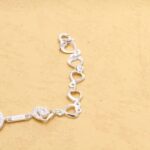Starting a diamond jewelry business can be a lucrative and fulfilling venture for entrepreneurs looking to enter the luxury goods market. With the growing demand for diamond jewelry, coupled with its potential profitability, it’s no wonder that many individuals are drawn to this industry.
Personally, I have always been captivated by the allure of diamonds and their timeless beauty. In this article, we will explore the various aspects of starting a diamond jewelry business and provide valuable insights and tips to help you navigate this exciting industry successfully.
The demand for diamond jewelry has seen significant growth over the years, with consumers worldwide embracing diamonds as symbols of love, affluence, and status. Whether it’s engagement rings, earrings, necklaces, or bracelets, diamonds continue to be sought after by customers from all walks of life. This growing demand creates ample opportunities for aspiring entrepreneurs to tap into a thriving market.
Moreover, the potential profitability of the diamond jewelry business is another compelling reason to consider starting your own venture in this industry. Diamonds have long been associated with opulence and exclusivity, resulting in higher profit margins compared to other products. By offering high-quality diamond pieces that cater to different customer preferences and budgets, you have the potential to create an immensely profitable business.
Before we delve deeper into the intricacies of starting a successful diamond jewelry business, it’s important to recognize that my love for diamonds stretches beyond their elegance and sparkle. Opening a diamond jewelry store allows me not only to share my passion with others but also provides an opportunity to connect with customers on a personal level as they embark on their own journeys involving these precious gems.
In the following sections of this article, we will guide you through each step of launching your own successful diamond jewelry business – from researching the market and developing a comprehensive business plan to sourcing quality diamonds and implementing effective marketing strategies. By understanding the industry landscape and equipping yourself with essential knowledge and skills, you’ll be well-prepared for the exciting and rewarding challenge of starting your very own diamond jewelry business.
Research the Market
Researching the market is a crucial step in starting a diamond jewelry business. Understanding the dynamics of the diamond industry will help you make informed decisions and position your business for success. In this section, we will provide an overview of the diamond market, explain the different types of diamonds, discuss certifications, and analyze market trends and consumer preferences.
Overview of the Diamond Market
Before diving into the diamond jewelry business, it’s essential to have a solid understanding of the market. The diamond industry is known for its high demand and potential profitability. According to industry reports, global sales of polished diamonds reached over $80 billion in 2019. As more consumers seek luxury goods and investments, the demand for diamond jewelry continues to grow.
Different Types of Diamonds
When entering the diamond jewelry business, it’s important to familiarize yourself with different types of diamonds. The four main factors that determine a diamond’s quality and value are carat weight, cut, clarity, and color. Carat weight refers to the size or mass of a diamond, while cut determines how well a diamond reflects light. Clarity is a measure of how clear or flawless a diamond is, while color refers to its hue.
Certifications: Ensuring Quality and Authenticity
Certifications play a vital role in guaranteeing the quality and authenticity of diamonds. The Gemological Institute of America (GIA) is widely recognized as one of the most reputable certification bodies in the industry. Other well-known certification organizations include European Gemological Laboratory (EGL), International Gemological Institute (IGI), and American Gem Society (AGS). Understanding these certifications and their standards will help you select high-quality diamonds for your inventory.
Market Trends and Consumer Preferences
To stay ahead in the competitive diamond jewelry market, it’s important to keep up with current trends and understand consumer preferences. Consumer tastes and preferences are ever-evolving, influenced by factors such as social media, celebrities, and cultural shifts.
It’s essential to analyze what styles, designs, and jewelry pieces are popular among your target market. By staying informed about market trends and adapting your offerings accordingly, you can attract more customers and drive sales in your diamond jewelry business.
By researching the market and gaining a comprehensive understanding of the diamond industry, you can position your diamond jewelry business for success. Understanding key market dynamics, different types of diamonds, certifications, and consumer preferences will help you make informed decisions when sourcing diamonds and creating an appealing inventory that caters to your target market’s needs and preferences.
Business Planning
Developing a solid business plan is essential for starting a successful diamond jewelry business. This section will guide you through the process of developing a comprehensive blueprint that outlines your goals, target market, competitors, and strategies.
Firstly, it is crucial to define your goals and objectives for the business. Consider what you want to achieve with your diamond jewelry business in terms of sales, growth, and brand recognition. Having clear goals will help you stay focused and motivated throughout the journey.
Next, create a comprehensive business plan that outlines the various aspects of your diamond jewelry business. This plan should include details about your product offerings, pricing strategy, marketing and advertising plans, operational structure, and financial projections. It will serve as a roadmap to guide your decision-making process and help attract investors or secure financing.
In addition to defining your goals and creating a detailed business plan, it is important to identify your target market and key demographics. Understanding who your customers are is essential for tailoring your products and marketing efforts towards their preferences and needs. Conduct market research to gain insights into consumer behavior patterns within the diamond jewelry industry.
Furthermore, analyzing potential competitors and their strategies is crucial for navigating in this highly competitive industry. Identify direct competitors who offer similar products or target similar customer segments. Study their pricing models, marketing tactics, and customer service practices to identify areas where you can differentiate yourself from them.
Developing a solid blueprint through setting clear goals, creating a comprehensive business plan, identifying target markets and understanding competitors will set a strong foundation for your diamond jewelry business.
| Aspect | Description |
|---|---|
| Goals | Set clear objectives for sales growth. |
| Business Plan | Create an all-inclusive document outlining product offerings, pricing strategy, marketing plans, etc. |
| Target Market | Identify the key demographics of your potential customers. |
| Competitor Analysis | Study direct competitors to differentiate yourself from their strategies and tactics. |
Financing Options
When starting a diamond jewelry business, one of the key steps is securing funding to bring your vision to life. There are various financing options available that can help you kickstart your business and ensure its success.
- Loans: Many entrepreneurs turn to loans as a source of funding for their diamond jewelry business. This can include traditional bank loans or alternative lending options such as online lenders or crowdfunding platforms. When applying for a loan, it’s important to have a well-prepared and detailed business plan along with accurate financial projections to demonstrate the profitability and potential of your venture.
- Grants: Depending on your location and specific circumstances, there may be grants available for small businesses in the diamond jewelry industry. Research local government programs or nonprofit organizations that provide grants to entrepreneurs in this field. Keep in mind that grants often have specific eligibility criteria and require a thorough application process, so be prepared to invest time in researching and applying for these opportunities.
- Investors: Securing investors can be another viable option for financing your diamond jewelry business. This involves pitching your business idea and financial projections to potential investors who are willing to provide capital in exchange for equity or other forms of return on investment. Look into angel investors, venture capitalists, or even family and friends who may be interested in supporting your entrepreneurial journey.
It’s crucial to thoroughly analyze each funding option and understand their pros and cons before making a decision. Consider factors such as interest rates, repayment terms, equity ownership, and the overall impact on your long-term financial stability.
To increase your chances of securing financing, it’s important to prepare a convincing business proposal that clearly outlines the potential profitability of your diamond jewelry business. Provide comprehensive market research, financial forecasts, marketing strategies, and an analysis of competitors when presenting your proposal to prospective lenders or investors.
Remember that starting any business requires adequate funding, but it’s essential not to overextend yourself financially. Carefully assess your budget and ensure you have a solid plan in place to allocate funds efficiently throughout the different aspects of your diamond jewelry business. With careful planning and smart financial decisions, securing funding for your venture can lead to a successful and thriving business.
Choose a Location
Choosing the right location for your diamond jewelry store is crucial to the success of your business. The location of your store can greatly impact your visibility, foot traffic, and overall sales. In this section, we will explore the importance of location in the jewelry industry and discuss factors to consider when selecting a store location.
One of the key factors to consider when choosing a location for your diamond jewelry store is foot traffic. You want to ensure that you are located in an area that receives a high volume of people passing by. This could be a busy shopping mall, downtown area, or a popular tourist destination. By being situated in an area with high foot traffic, you increase the chances of attracting potential customers and making sales.
Another important factor to consider is competition. It is essential to research the nearby jewelry stores and assess their product offerings and target market. If there are multiple competitors in close proximity, it may be more challenging to capture a significant share of the market. However, if you believe there is an opportunity for differentiation or specialization within the market, competing against nearby stores may not be a major concern.
Cost is another consideration when choosing a location for your diamond jewelry store. Leasing or purchasing a storefront can involve significant expenses, so it’s important to carefully evaluate your budget and financial projections. Additionally, operating an online store can offer several advantages such as lower overhead costs and access to a global customer base.
Building a Stunning Inventory
Building a diverse and stunning inventory is crucial for a successful diamond jewelry business. In this section, we will discuss the steps involved in sourcing and selecting diamonds to ensure the highest quality and value. We will also explore the importance of ethical sourcing and providing conflict-free diamonds.
Sourcing Diamonds from Reliable Suppliers
When building your diamond inventory, it is essential to establish relationships with reliable suppliers. Look for reputable diamond wholesalers or manufacturers who have a track record of supplying high-quality stones. Attend trade shows and industry events to network with potential suppliers and learn about their sourcing practices.
Verify that your suppliers adhere to ethical standards in their diamond sourcing process. Ensure that they comply with the Kimberley Process Certification Scheme, which aims to prevent conflict diamonds from entering the market. By partnering with ethical suppliers, you can assure your customers that your diamonds are responsibly sourced.
Evaluating Diamond Quality and Value
To provide customers with top-notch diamonds, it’s important to be able to evaluate their quality and value effectively. Familiarize yourself with the 4Cs of diamonds – carat, cut, clarity, and color. Learn how each factor contributes to the overall appearance and worth of a diamond.
Invest in gemological education or hire an experienced gemologist who can assist you in evaluating diamonds accurately. Consider obtaining certifications such as Gemological Institute of America (GIA) credentials, which can enhance your credibility as a diamond jewelry retailer.
Building a Diverse Inventory
Catering to different customer preferences is essential for maximizing sales potential. To achieve this, build a diverse inventory that offers various shapes, sizes, colors, and styles of diamonds. Consider adding fancy colored diamonds or unique cuts like pear-shaped or marquise-cut diamonds to appeal to a broader range of customers.
Track industry trends and consumer preferences closely so that you can adjust your inventory accordingly. Stay up-to-date with popular diamond jewelry designs, and offer both classic and contemporary options to satisfy different customer tastes.
Importance of Ethical Sourcing
In recent years, consumers have become increasingly conscious of ethical sourcing practices. Ensure that your diamonds are sourced ethically by maintaining transparency with your suppliers and verifying the origin of each stone. Opt for conflict-free diamonds and support companies that promote fair labor practices.
Communicate your commitment to ethical sourcing to customers through marketing materials, website content, and in-store signage. By doing so, you can attract socially conscious consumers who prioritize responsible business practices.
Building a stunning diamond inventory requires careful sourcing, evaluation of quality, diversification, and a commitment to ethical standards. By focusing on these aspects, you can set yourself apart from competitors and provide high-quality diamonds that will delight your customers.
Marketing Strategies
Once you have established your diamond jewelry business and have a stunning inventory, it’s crucial to develop effective marketing strategies to promote your brand and attract customers. In this section, we will explore various marketing channels and techniques that can help you increase awareness of your business and generate sales.
First and foremost, it’s important to develop a compelling brand identity and unique selling proposition (USP) for your diamond jewelry business. This will differentiate you from competitors and create a lasting impression on potential customers. Consider what sets your business apart – perhaps it’s exceptional craftsmanship, ethically sourced diamonds, or personalized designs. Incorporate these key elements into your branding strategy to effectively communicate the value of your products.
Next, leverage various marketing channels to reach your target audience. Social media platforms such as Instagram, Facebook, and Pinterest are ideal for showcasing visually appealing images of your diamond jewelry. Engage with followers by posting regularly, sharing behind-the-scenes content, and running contests or giveaways to increase brand visibility.
Email marketing is another powerful tool that allows you to directly communicate with potential customers. Build an email list by offering incentives such as exclusive discounts or access to limited-edition collections. Segment your audience based on their preferences and demographics to create personalized email campaigns that resonate with their interests.
Search engine optimization (SEO) is essential for improving the online visibility of your diamond jewelry business. Optimize your website content with relevant keywords that potential customers are likely to search for when looking for diamond jewelry online. Invest in professional web design to ensure a user-friendly experience that encourages visitors to browse through your products.
Influencer collaborations and partnerships can also be effective in reaching new audiences. Identify influencers who align with the values of your brand and have an engaged following within the luxury or fashion industry. Collaborate with them on sponsored posts or partnerships that feature your diamond jewelry prominently.
Lastly, organizing engaging events such as trunk shows or pop-up shops can create buzz and allow potential customers to see and try on your jewelry in person. Partner with other local businesses or luxury boutiques to host joint events that attract a larger crowd.
Implementing a well-rounded marketing strategy will help you build brand awareness, increase sales, and establish a loyal customer base. Continually monitor the effectiveness of your marketing efforts and adapt your strategies accordingly to stay ahead in the highly competitive diamond jewelry industry.
Customer Service and Sales
Building strong customer relationships is crucial for the success of a diamond jewelry business. Exceptional customer service and effective sales techniques are key to building trust, increasing customer loyalty, and driving repeat business. In this section, we will discuss strategies for providing outstanding customer service and increasing sales in the diamond jewelry industry.
Emphasize the significance of exceptional customer service
- Train your sales team: Provide thorough training to your sales team on product knowledge, diamond education, and effective communication skills. This will enable them to assist customers with confidence, answer their questions accurately, and provide personalized recommendations.
- Create a welcoming atmosphere: Make sure your store has an inviting ambiance that makes customers feel comfortable and valued. Greet customers as soon as they enter, offer them beverages or refreshments, and provide comfortable seating areas where they can browse through your inventory.
- Listen actively: Take the time to listen attentively to your customers’ needs, preferences, and budget constraints. This will allow you to tailor your recommendations accordingly and build strong relationships based on trust.
Tips on training and motivating your sales team
- Ongoing training: Continuously invest in the professional development of your sales team by organizing regular trainings and workshops. Keep them updated on industry trends, new product releases, and technological advancements in order to provide the best possible service to your customers.
- Incentives and rewards: Implement a performance-based incentive program that motivates your sales team to achieve targets and excel in their roles. Offer rewards such as bonuses, commission increases, or recognition within the company for outstanding performance.
- Encourage upselling techniques: Train your staff on effective upselling techniques without being pushy or aggressive. Teach them how to identify opportunities for additional sales by showing complementary pieces or upgrades that enhance the overall purchase.
Building customer loyalty
- Personalized interactions: Make an effort to remember your customers’ names, preferences, and important occasions. Send personalized emails or messages on special occasions such as birthdays and anniversaries, offering exclusive discounts or promotions to show your appreciation.
- Create a loyalty program: Implement a rewards program that incentivizes repeat purchases and referrals. Offer benefits such as exclusive discounts, early access to new collections, or special events for loyal customers.
- After-sales service: Follow up with your customers after their purchase to ensure their satisfaction with the product. Offer services such as cleaning, maintenance, and resizing to maintain the quality of their jewelry over time.
Providing exceptional customer service and building long-lasting relationships are vital in the diamond jewelry business. By focusing on these strategies, you can create a positive shopping experience that encourages customer loyalty and referrals, ultimately contributing to the success of your business.
Legal and Operational Requirements
Starting a diamond jewelry business requires careful consideration of the legal and operational requirements involved in the industry. Navigating the rules and regulations is crucial to ensure that your business operates legally and ethically, while also protecting your inventory and store.
To begin, it is important to understand the necessary permits and licenses for operating a jewelry business. Depending on your location, you may need to obtain specific licenses related to selling jewelry or precious stones. Research the local regulations and consult with legal professionals to ensure that you comply with all requirements.
Additionally, it is essential to register your business and obtain tax identification numbers. This step will provide legitimacy to your enterprise and enable you to operate within legal boundaries. Consult an attorney or financial advisor for guidance on registering your business and fulfilling tax obligations.
While setting up your business, it is crucial to consider legal considerations such as trademarks and intellectual property. Protecting your brand’s identity and unique selling proposition can help prevent unauthorized use by competitors or imitation by others in the industry. Investigate the process of obtaining trademarks or copyrights for your brand name, logo, or designs.
Insurance coverage is another significant aspect when it comes to protecting your inventory and store. Comprehensive insurance will safeguard against potential risks such as theft, damage, loss, or unforeseen events like natural disasters. Ensure that you have adequate coverage for not only diamonds but also other valuable assets like equipment or fixtures in your store.
By diligently navigating through these legal and operational requirements, you can establish a strong foundation for your diamond jewelry business. Compliance with regulations will help build trust with customers, suppliers, and stakeholders while also protecting your investments.
It is wise to seek professional advice throughout this process to ensure that all legal obligations are met effectively. With proper diligence in this area, you can focus on providing exceptional customer service, building long-lasting relationships, and growing a successful diamond jewelry business.
Frequently Asked Questions
How much does it cost to start a diamond company?
The cost to start a diamond company can vary greatly depending on several factors. One of the primary factors is whether you plan to mine and produce diamonds or if you intend to become a diamond trader or retailer.
Establishing a diamond mining operation involves significant expenses, which can range from millions to billions of dollars, as it necessitates exploration, licensing, purchasing or leasing mining equipment, and constructing or acquiring mining facilities. On the other hand, starting a diamond trading or retailing business might require smaller upfront costs and could be in the range of thousands to hundreds of thousands of dollars for inventory purchase, store setup, marketing campaigns, and operational expenses.
How can I start my own diamond business?
Starting your own diamond business requires careful planning and consideration of various aspects within the industry. First and foremost, gaining knowledge about diamonds is essential. Understanding how they are mined, cut, graded, priced, and distributed will create a strong foundation for your business.
You will need to decide whether to focus on mining diamonds yourself or if you prefer buying from suppliers. Next steps involve choosing a location for your business operations, securing necessary licenses and permits, developing relationships with reliable suppliers or miners if applicable, creating a marketing strategy to reach potential customers effectively, establishing partnerships with jewelers or retailers (if selling diamonds wholesale), and investing in valuable technology such as diamond grading equipment.
How much does it cost to start a jewelry business?
The cost involved in starting a jewelry business can vary widely based on the scale of your operations and the type of jewelry you plan to offer. If you intend to craft jewelry by hand or have it custom-designed using precious metals and gemstones like diamonds or pearls, start-up expenses can be considerable due to the cost of raw materials and specialized tools required for jewelry making.
On the other hand, starting an online jewelry store may require less initial investment since you may not need physical retail premises but would still need funds for building an e-commerce website that effectively showcases your products along with marketing efforts to attract customers. In general, costs for starting a jewelry business can range from several thousand dollars to tens of thousands, considering factors such as inventory, equipment, marketing, store setup (if applicable), packaging materials, and legal fees.

Welcome to my jewelry blog! My name is Sarah and I am the owner of this blog.
I love making jewelry and sharing my creations with others.
So whether you’re someone who loves wearing jewelry yourself or simply enjoys learning about it, be sure to check out my blog for insightful posts on everything related to this exciting topic!





